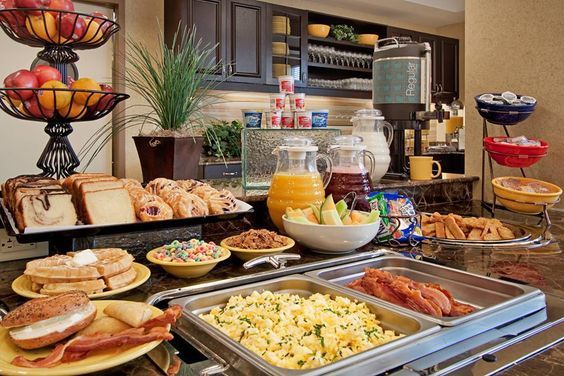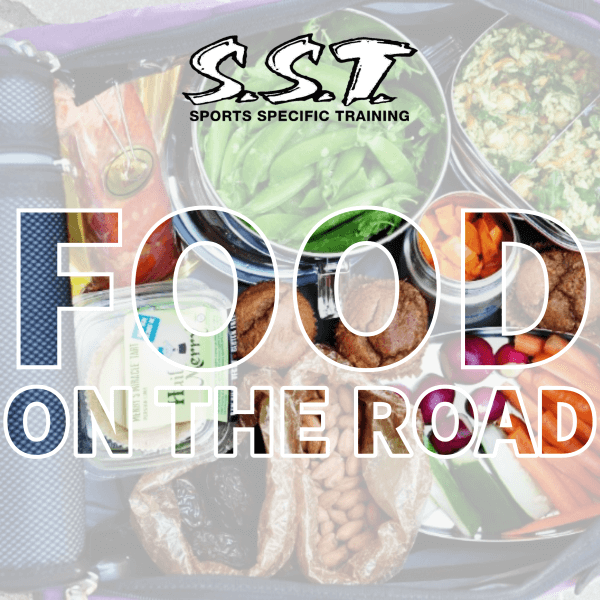Most athletes, once they reach the elite level, will have to do some traveling to training sessions, training camps, or competitions/tournaments. This travel can present a challenge to young athletes who are trying to take in enough calories to fuel their activity but that is healthy enough to keep them performing at an optimal level.
Once at their destination, athletes may stay in a variety of accommodations, from dorm rooms or hotels with not even a mini-fridge to fully equipped suites. This can make getting the proper nutrition tricky.
· If you do not have access to a fridge than some non-perishable snacks to keep with you should include – trail mix, dried fruit, dried chickpeas, beef jerky, pretzels, oatmeal, protein/meal replacement bar.
· If you do have access to a fridge and are able to keep more perishable snacks on hand choose things such as – veggies & hummus, chickpeas, fruit, roasted chicken, avocado with pita and chicken, nuts, jerky, Greek yogurt
As for meals there are usually a few options – hotel breakfast bar, restaurants, grocery store or fast food.
· Prior to your travel the coach/athlete/parents should do some research to find suitable restaurants and grocery stores near the athletes’ training and competition venues
· To support optimal performances in training and competition, a selection of whole grains, vegetables, fruit, and lean meat should be emphasized from restaurant menus and store purchases.

Smart Choices for eating at a Hotel Breakfast Bar:
· Plain yogurt (preferably Greek, if available) with fresh fruit
· 1-2 Oatmeal packet (make with 2% milk or water) and handful of nuts or cinnamon
· Peanut butter + fresh fruit (i.e. banana, apple, strawberry) on whole wheat toast
· 2-3 hardboiled eggs + fruit
· Omelet bar (2-3 eggs + veggies + cheese + meat)
· Scrambled eggs and fruit
· 1-2 Single serve cereal (cheerios or oat bran) with milk. Skip the surgery options!
· Whole wheat toast with eggs & 1-2 slices of bacon
*These are just suggestions, you need to eat enough to feel that you have enough fuel for the day. You can mix and match all good choices to make a large enough meal (ie. Greek yogurt with fruit + oatmeal package with nuts + scrambled eggs on whole wheat toast)
AVOID
· Sugary cereals (such as frosted flakes, fruit loops, etc.)
· Muffins, croissants, pastries
· Pancakes with maple syrup
· Overloading the bacon, try to stick to 1-2 pieces at most
· Bagels and cream cheese
· Fruit juices
· Coffee, tea, or other caffeinated/sugary beverages
Smart Choices for eating at a Restaurant:
When eating at a restaurant be smart, choose more vegetables, fruit and lean meats and cut down on excess fat, salt and refined sugar.
· Read menu descriptions to make the best choices –Try to avoid battered/deep-fried, breaded, creamy, crispy, au gratin or in cream sauce. These options are often high in calories, unhealthy fats and/or sodium
· Be careful with salt – restaurant food tends to be high in sodium. Instead of salty fries, order a side salad and ask for vinegar & oil based dressings on the side
· Stay away from high calorie drinks – pop is a huge source of hidden and empty calories. Try drinking water, or milk instead. Diet drinks do not refuel muscles during recovery.
· Avoid super-sized portions – Some restaurant meals can run up to 1000-2000 calories or more. Choose a smaller portion size, order a side salad instead of fries and choose water as your beverage.
· Special order – ask for baked, broiled, steamed, or stir-fried, instead of battered, deep-fried items. Request vegetables and main dishes without rich sauces. Avoid large amounts of dressings, spreads and extra cheese. Choose oil & vinegar or Italian dressings in small amounts or ask for them “on the side.”

Smart Choices for eating at Common Fast Food Restaurants:
If at all possible try to avoid fast food restaurants while on the road and use them only as a last resort. However, when food cannot be purchased at a grocery store and there is no time for a sit down restaurant, this may be the only option.
Fast food doesn’t have to be all bad as they provide quick service, inexpensive food of consistent quality, and can be easily accessible, but thought has to be put into food selection in order to keep you nutrition and performance in check.
Subway
· Choose whole wheat bread or salads
· Loads of veggies, ANY kind
· Choose meats such as chicken breast, turkey or tuna
· Dressings such as mustard or house dressing/Italian
Avoid
· White bread and bread with extra cheese on top
· Deli meats and those covered in sauce such as; cold cut, sweet onion teriyaki, meatball, or butter chicken
· Extra cheese or bacon
· Creamy or mayonnaise based sauces
· Fountain drinks or pop
· Chips/cookies
McDonalds
· Breakfast
o Egg McMuffin – sausage or ham
o Breakfast wraps – Kale & Feta
o Yogurt and fruit
o Oatmeal and dried fruit
Avoid
o McGriddles
o Hash browns
o Bagels
o Biscuits
o Muffins
o Fruit Juice
· Lunch /Dinner
o Grilled chicken wraps- sweet chili
o Grilled chicken sandwiches – ‘The 12’
o Greek Salad
Avoid
o Burgers & Double burgers
o Creamy sauces – McChicken Sauce, Big Mac Sauce, BBQ
o Fries
o Fountain drinks & Juice
o Cesar Salad
o Desserts – pies, ice cream, cookies, pastries
Pizza
· Loads of veggies
· Lean meats like chicken, ham or back bacon (Canadian Bacon)
· Thin crust
· Feta cheese instead of mozzarella
Avoid
· Extra cheese
· Thick crust/stuffed Crust
· Fatty meats – peperoni, sausage, bacon, ground beef, porchetta
Chick-fila
· Breakfast burrito
· Oatmeal
· Greek yogurt
· Salad with dressing on the side (vinaigrette options)
· Wraps/sandwiches with grilled chicken
· Side Salads w/ vinaigrette dressings on the side
Avoid
· Fried chicken options
· Biscuits
· Bagels
· Cinnamon buns/pastries
· Hash browns/French fries
· Creamy dressings/BBQ Sauces






